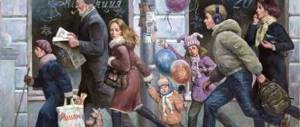Class hour lesson 'Autumn holidays are my safety'
Conversation
“Behavior during the autumn holidays. Thin ice, autumn forest, traffic rules"
Goals:
- study the safety rules for students during the autumn holidays
- remind you about road safety rules in autumn
- remind you of the safety rules on the pond in the fall
- remind you about personal safety rules in the evening
Progress of the conversation:
- Safety rules during the autumn holidays:
- You must be careful and attentive on the street, when crossing the road; follow traffic rules;
- Follow safety rules when walking in the forest or on the river: 2.1. It is prohibited to light fires in the village and forest areas; 2.2. Do not swim in cold weather. 2.3. Be careful when visiting forest areas and encountering wild animals. 2.4. It is forbidden to eat unfamiliar and unfamiliar mushrooms and berries.
3. It is necessary to take care of your health; carry out preventive measures against flu and colds;
4. Be careful when contacting electrical appliances, follow safety precautions when turning on and off the TV, electric iron, kettle, etc.
5. Observe safety precautions when using gas appliances;
6. Observe the time mode when watching TV and working on the computer;
7. Observe safety precautions when working with piercing, cutting and chopping tools;
8. It is prohibited to visit tractor teams, garages, farms without adult accompaniment;
9. Be careful when handling pets;
10. It is prohibited to be on the street without an adult in the summer after 23.00, in the winter after 22.00.
2. Road safety rules in autumn:
In autumn the weather changes: it rains more often, leaves begin to fall, and it gets dark earlier. There is a lot of traffic on the roads, the number of children is increasing: everyone has returned home because the new school year has begun. Many of you have forgotten the rules of safe behavior on the roads. We will talk about them now, try to remember them.
- The first condition for traffic safety on the road is the ability to choose the right safe crossing point. In each specific situation, you choose the option that suits you, without violating traffic rules (traffic regulations). Let's try to remember safe places to cross the road.
- Underground crossing
(under the roadway). Ground crossing (above the roadway). Pedestrians moving along them do not interfere with transport and are safe themselves.
- Crosswalk,
indicated by a road sign and markings on the asphalt in the form of white stripes (“Zebra”). Pedestrians should stay on the right side while driving along the Zebra crossing. Crossing the roadway is permitted only by one road sign, which is square in shape and painted blue and white.
- When the traffic light is green.
If the green signal is flashing, this means that its operating time is ending and the yellow traffic prohibiting signal will soon turn on. Wherever pedestrian traffic lights (two-section) are installed, pedestrians are required to obey only their signals.
- By permission signal from the traffic controller.
Pedestrian movement is allowed from the left and right sides if the traffic controller has his arms extended to the sides or lowered; and it is also allowed to cross the road behind the back of the traffic controller when his right arm is extended forward.
- Before you step onto the roadway, always make sure that there are no vehicles near you (look left, right, left, and only then step off the curb!
- Guys, autumn is ahead, which means there will be fewer and fewer clear days. In bad weather, walking on wet asphalt is more difficult - you can slip, fall, and get injured. All this must be taken into account when crossing the road. The main thing is not to rush! Close the umbrella, lower the hood. Rain is not at all dangerous compared to a flying car!
- Autumn means short days and rapid onset of darkness. Remember this. Even small holes and bumps that you don’t notice during the day can cause trouble: you stumbled, fell... What if it’s on the roadway? Therefore, be especially careful!
- It’s not easy for drivers in the dark in bad weather either - the light of car headlights is reflected in puddles and on wet asphalt and disorients drivers. Therefore, it is very important that you guys remember about reflectors, flickers and other reflective devices. Attach them to your clothes, hat, briefcase, backpack, bag, and the driver will see you. If there is nothing like this, use a flashlight to illuminate the road ahead of you.
And remember, guys, that by knowing the traffic rules and skillfully applying them, you save your health and life
!
- Safety rules for an autumn pond.
- Before going down onto the ice, check the place where the ice adjoins the shore - there may be gullies that are closed by snow blows. At river mouths, ice strength is weakened by currents.
- When moving on ice, check its strength with available means (a pole or a ski pole). Testing the strength of ice by kicking is dangerous!
- The safest way to cross a river or lake is on skis. Be sure to unfasten the ski bindings and remove the ski pole loops from your wrists. It is best to move along a well-worn ski track.
- Transparent ice with a bluish or greenish tint is considered durable. Unstable ice is matte or white. This color of ice is obtained when, during a thaw, frost, rain or after a snowfall, it becomes covered with water and then freezes.
- If you accidentally get on thin ice, move back with sliding, careful steps, without taking your feet off the ice.
- If you fall through , don’t panic, take off your heavy shoes and clothes, spread your arms wide along the edges of the ice so as not to plunge headlong, lean on the edge of the hole, slowly lying down on your stomach or back. Move to the edge of the ice hole where the current does not drag you under the ice. Try to get onto the ice without sudden movements, crawling with your chest and alternately pulling your legs to the surface, spreading them wide. Take advantage of objects floating nearby or rising above the water. Having got out of the hole, roll away from it and crawl in the direction from which you came.
- If a person fails before your eyes , immediately shout to him that you are coming to help. Approach the hole at a crawl, with your arms spread wide. It will be better if you add skis or plywood to increase your support area. You cannot crawl to the very edge of the hole, otherwise you may end up in the water. Belts or a scarf, any board, pole, skis will help you save a person. You need to throw tied objects at a distance of 3-4 m. If you provide assistance yourself, then you must lie down on the ice, give the victim a stick, pole, belt or scarf, etc., to help him get out of the water. Then take the victim to a warm room, rub him dry, change clothes, and give him hot tea. If necessary, provide first aid or transport to a medical facility.
- If you are not alone, then take each other’s legs, lie down on the ice in a chain and move towards the break. Act decisively and quickly: the victim quickly becomes numb in the icy water, and wet clothes pull him down. Having given the victim a handy remedy, pull him onto the ice and crawl away from the danger zone.
- Remove the victim's clothes and put on dry ones. If you don't have dry clothes, wring out the wet ones and then put them on again. Wrap the victim in polyethylene if possible - a greenhouse effect will occur.



